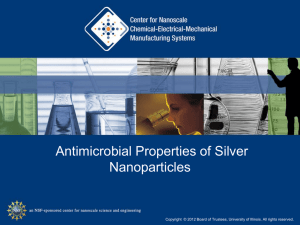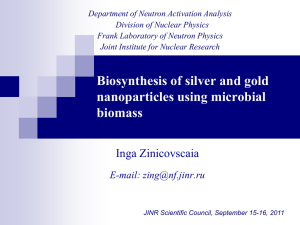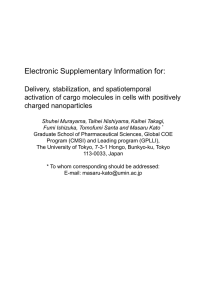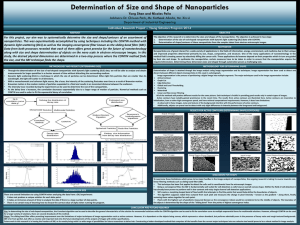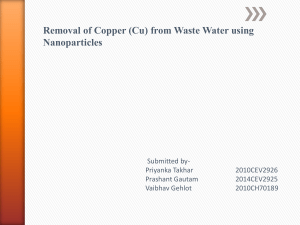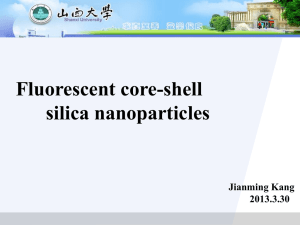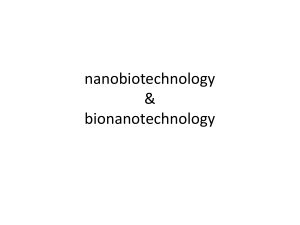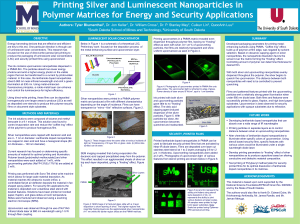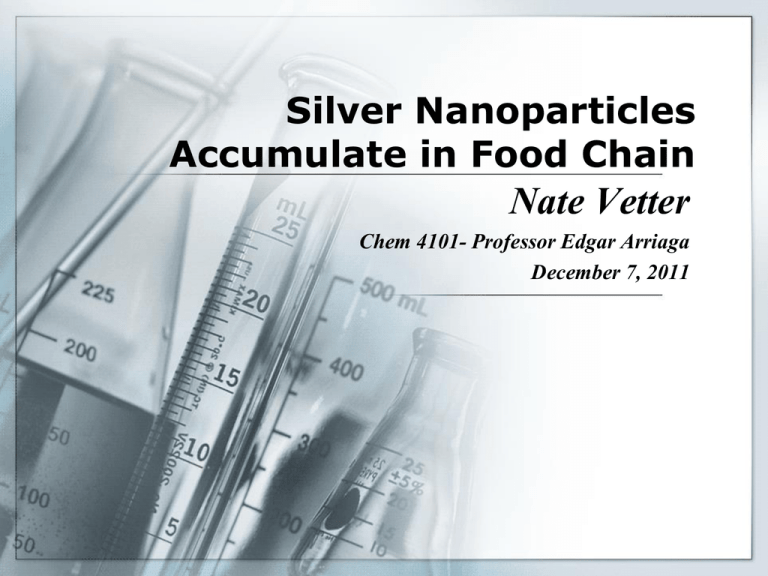
Silver Nanoparticles
Accumulate in Food Chain
Nate Vetter
Chem 4101- Professor Edgar Arriaga
December 7, 2011
Problem Statement and
Hypothesis
Problem Statement
Silver nanoparticles are being used in wound
dressings, catheters, and various household products.
Little research has been conducted to evaluate the
impact of nanoparticles on terrestrial ecosystems
Hypothesis
My hypothesis is silver nanoparticles can end up in the
drainage, sewage, and waste water we expel which
can make its way to the terrestrial ecosystems.
Insects can uptake these nanoparticles and the
nanoparticles can translate up the food chain as
predators eat the prey.
Overview
Main Analyte: Ag0 Nanoparticles 5-20 nm
Possible Concentration in soil: 2.0 to 7.0 μg kg−1
Matrixes: Waste Water, Soil, Plant Material, Worm
Tissues
Figure 1. Retrieved from Judy J. D. ; Unrine J. M. ; Bertsch P. M. Environ. Sci. Technol. 2011, 45, 776-78
Requirements for Successful
Analysis
1)Must be able to detect small amounts of analyte
a. Low Limit of Detection
2)Must be able to detect small changes in analyte
Concentration
a. High Sensitivity
3)Results must be reproducible and timely
a. High Precision
b. High Accuracy
c. Fast (minutes, not hours)
Studies Needed to Test
Hypothesis
Identify waste streams with nanoparticles present.
Determine greatest area of concentration of silver
nanoparticles.
Measure concentration of silver nanoparticles in soils near
waste streams of interest.
Based on concentrations of silver
nanoparticles found in soil, construct
a study similar using concentrations
below, at, and above to determine the
effect on accumulation in worms.
Figure 2. Retrieved from
http://toxics.usgs.gov/highlights/tracing_wast
ewater.html(accessed Dec 7, 2011)
Possible Separation Techniques
Technique
Ion-exchange
Chromatography
Pros
-Fast (minutes)
-Low detection limit
(ppm)
Size Exclusion
Chromatography (SEC)
Capillary Electrophoresis
(CE)
Cons
-Other Ions can be detected
-Only separation method is
retention time
-analyte must be charged
-Separation based on
particle size
-Fast
-No physical or
chemical interaction
with analyte
-Upper and lower limit to
retention time
-Very Fast analysis
-Low detection limit
-Expensive equipment
-Possible irreversible
adsorption of the particles
by column packing material
Possible Detection Techniques
Technique
Pros
Cons
Ultraviolet- Visible
Absorption (UV-Vis)
-Simple
-Easy to use
-Cheap
-High Limit of Detection
-Can have high signal
noise
-Requires Standards
Atomic absorption
Spectroscopy (AAS)
-Low Limit of Detection
-Requires Standards
- Slow
-Specialized Equipment
-Can use solid sample
Inductively Coupled
Plasma – Mass
Spectroscopy (ICP-MS)
-Low Limit of Detection
-Can use solid sample
-Highly Sensitive
-Requires Standards
-Specialized Equipment
Best Separation Technique: Ionexchange Chromatography
Simplified Exchange Equilibrium:
It is a non-denaturing technique
Speed: Fast (minutes)
High Selectivity
Example data output
Figure 3. Retrieved from Skoog, D.A.; Holler, Figure 4. Retrieve from Skoog, D.A.; Holler, F. J.; Crouch, S.
F. J.; Crouch, S. R. Principles of Instrumental R. Principles of Instrumental Analysis, 6th ed.; Cengage
Analysis, 6th ed.; Cengage Learning: California, Learning: California, 2007.
2007.
Best Detector: AAS
Multi-element analysis
Possible limit of detection:
0.1 – 100 pg
AA-500 series specifications
High Sensitivity - > 0,85 Abs
with 5ppm Cu
Resolution – Better than 0.25
nm at 200 nm
Figure 6. Retrieve from EPOND.
AAS Instrumentation. http://www.epond.biz/aas_instr.html(accessed Dec
7, 2011)
Figure 5. Retrieved From Skoog, D.A.; Holler, F. J.; Crouch, S. R. Principles of
Instrumental Analysis, 6th ed.; Cengage Learning: California, 2007.
Experimental Sample Preparation
Figure 7. Retrieved from
http://www.dynamicstar.co
m.hk/page12.html(Accesse
d Dec 7, 2011)
Digestion/microcentrifuge - Using
hydrochloric acid and hydrogen
peroxide, digest the tissues of the
worms or food source. Centrifuge
the sample to extract the silver
from the matrix.
Figure 8. Retrieved from
http://www.komline.com/d
ocs/rotary_drum_vacuum_f
ilter.html(Accessed Dec 7,
2011)
Figure 9. Retrieved from
http://www.willequipped.
com/rotovap.html(accesse
d Dec. 7, 2011)
Vacuum Filter – Pores on filter
should remove debris in sample
but not impede nanoparticles.
Dry/Store – Rotovap to remove
solvents and store at room
temperature until needed
Possible Outcomes
Predicted Results:
Worms cannot shed the silver nanoparticles efficiently,
resulting in concentration in tissues far exceeding that of their
food source.
The results of this study should demonstrate trophic transfer and
biomagnification of silver nanoparticles from a primary producer to a
primary consumer.
The observation that nanoparticles could
biomagnify highlights the importance of
considering dietary uptake as a pathway for
nanoparticle exposure. This raises questions
Figure 10. Retrieved from
about potential human exposure to nanoparticles http://cen.acs.org/articles/88/web/2010
/10/Nanoparticles-Worm-Way-Foodfrom long-term land application of biosolids.
Web.html(accessed Dec 7, 2011)
References
1. AshaRani, P. V.; Kah Mun G. L.; Hande M. P.; Valiyaveettil, S. Cytotoxicity and Genotoxicity of Silver
Nanoparticles in Human Cells. ACS Nano, 2009, 3 (2), 279-290
2. Jensen, T.; Schatz, G.C.; Van Duyne, R. P. Nanosphere Lithography: Surface Plasmon Resonance
Spectrum of a Periodic Array of Silver Nanoparticles by Ultraviolet−Visible Extinction Spectroscopy and
Electrodynamic Modeling. J. Phys. Chem. B.1999, 103, 2394-2401
3. Judy J. D. ; Unrine J. M. ; Bertsch P. M. Evidence for Biomagnification of Gold Nanoparticles within a
Terrestrial Food Chain. Environ. Sci. Technol. 2011, 45, 776-78
4. Lim, S. F.; Riehn R.; Ryu W. S. ; Khanarian N. ; Tung C. ; Tank D. ; Austin R. H. In Vivo and Scanning
Electron Microscopy Imaging of Upconverting Nanophosphors in Caenorhabditis elegans. Am. Chem.
Soc. 2006, 6, 169-174
5. Link, S.; Wang, Z.L.; El-Sayed, M.A. Alloy Formation of Gold-Silver Nanoparticles and the Dependence of
the Plasmon Absorption on Their Composition. J. Phys. Chem. B.1999, 103, 3529-3533
6. Journal of Nanobiotechnology. Silver nanoparticles.
http://www.jnanobiotechnology.com/content/3/1/6/figure/F1?highres=y (accessed Oct 26, 2011)
7. Nanocs. Silver nanoparticles. http://www.nanocs.com/Silver_nanoparticles.htm (accessed Oct 26,
2011)
8. Wei, G. T.; Liu, F.K.; Wang C. Shape Separation of Nanometer Gold Particles by Size-Exclusion
Chromatography. Anal. Chem. 1999, 71, 2085-2091
9. Skoog, D.A.; Holler, F. J.; Crouch, S. R. Principles of Instrumental Analysis, 6th ed.; Cengage Learning:
California, 2007.



